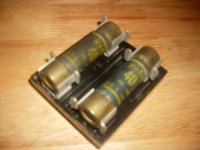Browsed back 10 pages, didn't see what I was looking for so here I am.
Going to be wiring 2 standard 120V dual outlets off a 240V range plug, and I'm looking for some affirmation.
So, 2 hots, a ground, and a neutral. One hot to each 120V outlet, split the neutral to each outlet and ground the ground. Am I on drugs or am I in the ballpark?
I have done a ton of 240V wirings back in my oil patch days but it has been years and I never ever trusted something I couldn't see. I'd pay an electrician but I have a good feeling that it isn't complicated enough for 'expert' money.
DB
Going to be wiring 2 standard 120V dual outlets off a 240V range plug, and I'm looking for some affirmation.
So, 2 hots, a ground, and a neutral. One hot to each 120V outlet, split the neutral to each outlet and ground the ground. Am I on drugs or am I in the ballpark?
I have done a ton of 240V wirings back in my oil patch days but it has been years and I never ever trusted something I couldn't see. I'd pay an electrician but I have a good feeling that it isn't complicated enough for 'expert' money.
DB




